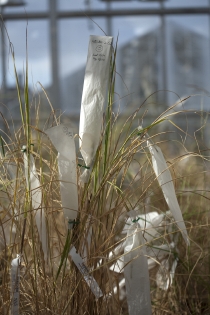COVER STORY SIDEBAR
Rice bred without corporate love

Rice plants in a Cornell greenhouse, their seed panicles bagged so the plants self-pollinate instead of cross pollinating with others in the greenhouse. See larger image
Maize, soybean and cotton are crops with strong market value in the United States – where more than 70 percent of U.S. production consists of genetically modified (GM) varieties – and these crops are heavily backed by corporations that own the patent rights to GM seeds.
But rice is another story when it comes to corporate support.
Rice is not commercially produced as a GM crop anywhere in the world. Furthermore, the U.S. is a relatively small player, producing only about 1.5 percent of the global rice crop. Unlike major GM crops that are grown primarily as animal feed or fiber, rice is the main foodstuff for half the world's population, including many of the most impoverished people on the planet.
"The fact that over 90 percent of rice is consumed within a few miles of where it is produced has huge implications for rice research," says Cornell rice geneticist Susan McCouch. "We don't depend on corporate intermediaries to translate science into public good."
While there are hundreds of maize and soy geneticists in the United States, the number of rice geneticists in the country can be counted on two hands, McCouch says. She and her colleagues, supported by government and private – not corporate – funds, do pioneering work exploiting the natural genetic variation found in wild rice. Public sector institutions around the world can use the open-source platforms created at Cornell to facilitate breeding local varieties of rice with higher yields, disease resistance or stress tolerance, and they can do so on their own terms.
"We work hard to partner with those who have a responsibility to feed hungry people," says McCouch. "The role of rice research at a university like this is not about generating revenue – it's about the public mission of Cornell."